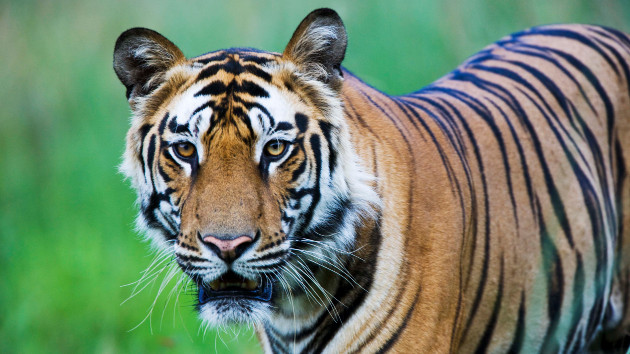
(NEW YORK) — Global conservation efforts to save tigers have far exceeded expectations, according to experts. There have, however, also been unintended consequences.
Nepalese Prime Minister Sher Bahadur Deuba announced Friday, on International Tiger Day, that the number of tigers in the country has increased 290% since 2009. The revelation surpasses the joint target set by the government and conservationists, Narendra Pradhan, the Nepal program coordinator for the International Union for Conservation of Nature, told ABC News.
Nepal, a landlocked Asian country nestled in the Himalayan Mountains, is one of 13 countries that committed to doubling its tiger population during a 2010 international tiger summit in Saint Petersburg, Russia.
But as the number of tigers in Nepal continues to grow, so does the conflict between tigers and their human neighbors.
In the last year, tigers have killed three people every month on average, according to Nepalese officials.
Very few of these attacks involve “problem tigers” that venture from the forests and national parks to attack humans and livestock, Mayukh Chatterjee, field program manager for the Chester Zoo in the U.K. and a member of the IUCN’s Human-Wildlife Conflict & Coexistence Specialist Group, told ABC News. Many Nepalese live in subsistence farming communities and the majority of the attacks occur when they are foraging, Smriti Dahal, program coordinator for the World Wildlife Fund’s Tigers Alive Initiative and a native of Nepal, told ABC News.
Sometimes the attacks occur when the farmers bring their livestock, such as goats and cows, to the forest because they are unable to collect enough fodder, Dahal said.
Tigers are elusive and shy, Pradhan said, adding that the attacks likely occur when they feel startled or threatened.
Part of the reason why tigers have flourished in countries like Nepal, India, Bhutan, Bangladesh and Sri Lanka is because these cultures revere big cats, experts said. Other Southeast Asian countries, such as Cambodia, Laos and Vietnam, have continued to see a decline or even total extinction of tigers.
India is also seeing an increase of human-tiger conflict as a result of the soaring numbers, Chatterjee said.
In his address on Friday, Deuba stressed the necessity for more strategic methods of tiger habitat management due to the conflict, which he said is taking place in the absence of adequate food and water.
Communities in tiger countries are rapidly changing as development continues and people move around geographically, Dahal said. As humans produce more food to fulfill growing populations, tigers and humans will begin to share more space.
While conservationists are pleased with their efforts, the focus is now on educating locals on safety and getting them involved in conservation efforts, Chatterjee said.
In addition, partners in the tiger initiative will need to monitor and perhaps slow the growth in some populations. Tigers are “very prolific breeders” and not much thought was given a decade ago to how tigers would peacefully coexist with an ever-growing human population, Chatterjee said.
Further growth in tiger populations will only lead to more human-tiger conflicts as the number of individual tigers move out of the secure conservation lands, Chatterjee said.
Communities are aware and support the tiger conservation work, Pradhan said. But partners in the tiger initiative will need to be mindful of the conflict, because as humans continue to lose their livestock and even their lives, resentment toward the big cats could begin, Chatterjee said.
“We don’t want that social tolerance to go down one day and people start killing because they’ve reached a limit where they cannot live with tigers,” Dahal said.
Copyright © 2022, ABC Audio. All rights reserved.








